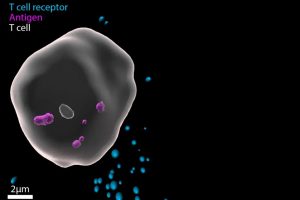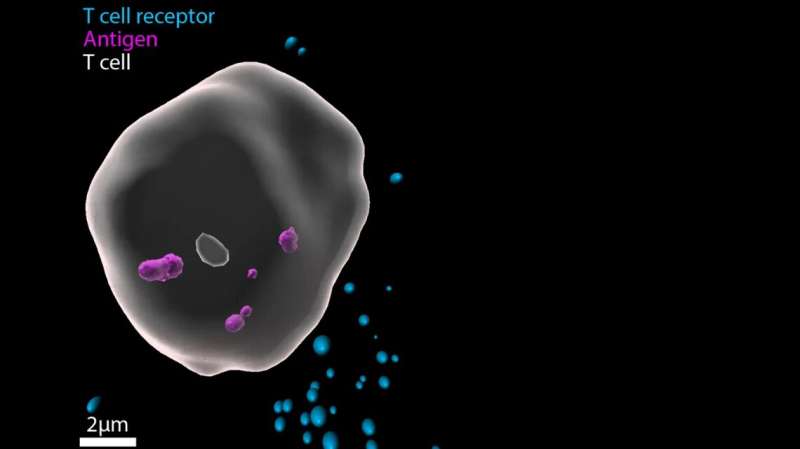Communication at the crossroads of the immune system


In a article in the Proceedings of the National Academy of Sciences, Prof Mike Dustin and his research team have explained how messages are passed across the immunological synapse. The research could have implications for future vaccine development and immunotherapy treatments.
The work started with Audun Kvalvaag’s interest in clathrin, a protein that is well known for its role in bringing substances such as cholesterol and iron into cells for nutrition, and to generate small packages of information that can be released from cells called exosomes. Dr. Kvalvaag, a visiting scholar from Oslo, Norway, led the team in Dustin’s lab that identified new roles of clathrin in the immunological synapse.
“Using state of the art microscopy tools, including the eTIRF-SIM that was custom built at the Kennedy Institute, we have found that clathrin is a common scaffold for pushing messages from T cells onto antigen presenting cells (APCs), and pulling messages into the T cells from the APCs,” said Audun.
“Messages in the form of vesicles are pushed directly from the plasma membrane of T cells through a process we termed clathrin- and ESCRT-mediated ectocytosis (CEME), while T cells pulling vesicles from the APCs is based on the process of clathrin-mediated endocytosis (CME). The choice of which direction the vesicles move is controlled by different adaptors, called HRS and EPN1, respectively.”
The immunological synapse is the crossroads of the adaptive immune system, through which helper T cells instruct B cells to induce antibody production or killer T cells latch onto infected and cancerous cells to eradicate them.
During activation, T cell receptors attach to peptide–MHC (pMHC) complexes and initiate T cell activation and TCR ubiquitination. Dustin and colleagues have championed the idea that ubiquitinated TCRs can be ectocytosed by the T cell and pushed toward the antigen-presenting cell in extracellular vesicles, but how this was reconciled with many prior observations of T cells pulling pMHC from the antigen presenting cell into the T cell was a mystery.
This study found that clathrin in fact governs both processes through bidirectional membrane exchange at the immunological synapse. The choice of direction of movement is coordinated by the adaptors that link the TCR to clathrin to enable ectocytosis or endocytosis.
In the first instance, clathrin is recruited to TCR microclusters by HRS to initiate release of TCR by CEME. Subsequently, EPN1 recruits clathrin to remaining TCR-pMHC clusters to enable trans-endocytosis of engaged pMHC from the antigen presenting cell.
“Based on this information we may be able to engineer T cells to be better communicators at the crossroads,” said Michael, “which has implications for vaccination and cancer immunotherapy.”
More information:
Audun Kvalvaag et al, Clathrin mediates both internalization and vesicular release of triggered T cell receptor at the immunological synapse, Proceedings of the National Academy of Sciences (2023). DOI: 10.1073/pnas.2211368120
Journal information:
Proceedings of the National Academy of Sciences
Source: Read Full Article




